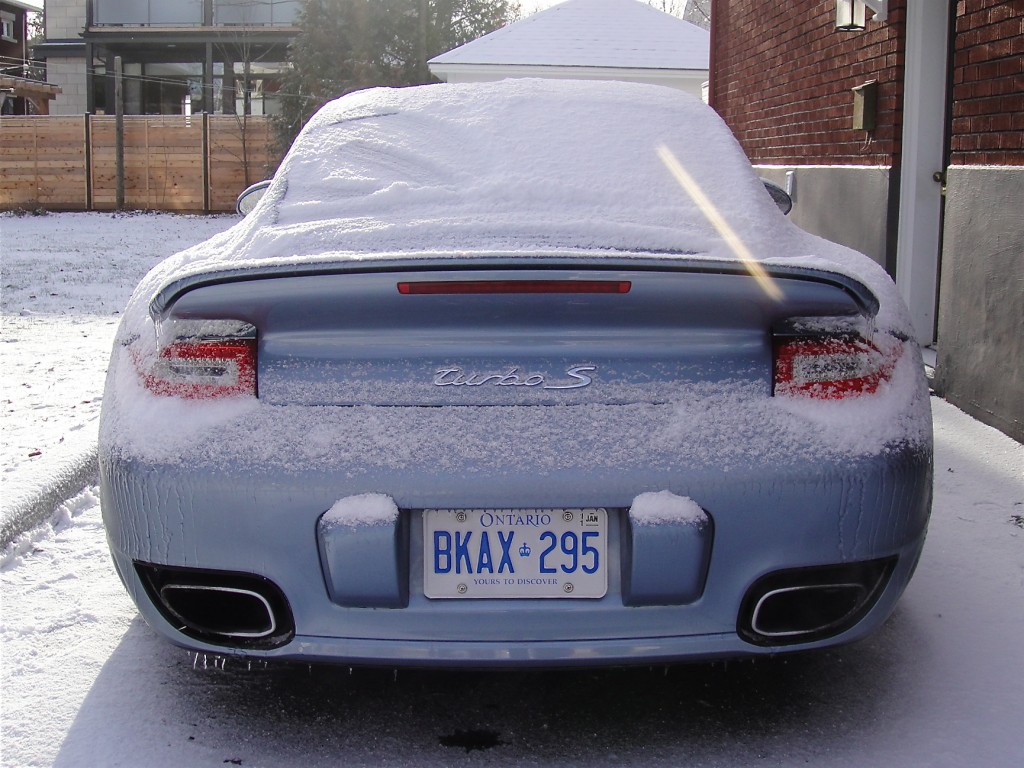The Crank: Can an all-wheel-drive 911 be a real Porsche?
By John LeBlanc
Welcome to winter. Like the rest of Ontario, you probably woke up to the inevitable First Big Dump this week. But what if you had a Porsche in your laneway. Specifically, a new-for-2011 911 Turbo S, which, to the layman’s eyes, seems like the most ridiculous winter vehicle you could drive. But unlike most Porsche’s that aren’t SUVs, this new 911 Turbo S had traction not only at its rear wheels, but at its front pair as well. Which, the snob that I am, meant that despite the car’s 530 hp at my disposal, I wasn’t clutching its keys in anticipation.
You see, the words “all-wheel-drive” and “Nine-Eleven Turbo” just don’t jive with me. I grew up with the original 1975 to 1989 911 Turbo, the 930. It was Porsche’s range-topper, the fastest production car available in Germany in its day. And it also liked to play Freddy Kruger with its drivers. Although its 256 hp rating wouldn’t scare a Camry V6 driver these days, apparently, the combination of an the 930’s lightswitch power whump from its single megaphone turbocharger, and tennis-ball-in-sock rear weight bias meant any lack of attention at the helm, or inappropriate use of its gas pedal, had the 930 oversteering like Ken Block with a camera nearby.
The 930 wasn’t for hacks. It needed to be driven with élan and skill via its two rear wheels. With no NASA-grade electronic nannies—or heaven forbid!—traction at all four wheels, unskilled pilots would pirouette their 930s into ditches, Armco barriers, nearby cornfields—you name it—whether the roads were dry or not. Driving a 930 in the snow? Fuhgeddaboutit! So when the German automaker added traction to the front of the normally rear-driven-only 911 in the early 1990s, I’m sorry Ferry, you lost me. So what to make of the latest, ALL-WHEEL-DRIVE 911 Turbo S?
The first new 911 Turbo S model in five years certainly delivers more for the extra $32,100 Porsche asks over a cooking $167,900 Turbo. Except for the Porsche Club Racing-ready $297,000 GT2 RS and its 620 hp, the Turbo S is the most-powerful 911 you can buy. Thanks to its twin turbochargers with variable turbine geometry, the über-Turbo’s 3.8-litre flat-six makes 530 hp—30 more than a regular Turbo.
So in my mind, it’s just a quicker version of an AWD 911 I don’t want to drive. In fact, I had a chance to drive the Turbo S back-to-back with the also-new-for 2011 911 GT3, back in August. In the Porsche 911 lineup, the GT3 is the bridge between the more road-biased Turbo S and the race-ready $166,300 GT3 RS and the GT2 RS models (RennSport is German for “racing sport”). It’s the current 911 of my dreams, and at $142,000, it’s a relative bargain.
But then…I couldn’t/wouldn’t dare drive the GT3 this week. Or probably not until next April.
The rational side of my brain says Porsche offers enough 911s to keep many more customers happy than it did back in the 1970s. That’s good for their bottom line. And all-wheel-drive lets some of its owners rationalize the car to the spouse as more than just a summer toy. So maybe the idea of a mega-horsepower, all-wheel-drive sports car like the 911 Turbo S makes sense to some buyers. But for me, I’ll still take my 911 with power to the back, a set of snow tires, and the proper skill required.






![[del.icio.us]](https://www.straight-six.com/wp-content/plugins/bookmarkify/delicious.png)
![[Digg]](https://www.straight-six.com/wp-content/plugins/bookmarkify/digg.png)
![[Facebook]](https://www.straight-six.com/wp-content/plugins/bookmarkify/facebook.png)
![[Google]](https://www.straight-six.com/wp-content/plugins/bookmarkify/google.png)
![[Reddit]](https://www.straight-six.com/wp-content/plugins/bookmarkify/reddit.png)
![[StumbleUpon]](https://www.straight-six.com/wp-content/plugins/bookmarkify/stumbleupon.png)
![[Twitter]](https://www.straight-six.com/wp-content/plugins/bookmarkify/twitter.png)
![[Email]](https://www.straight-six.com/wp-content/plugins/bookmarkify/email.png)